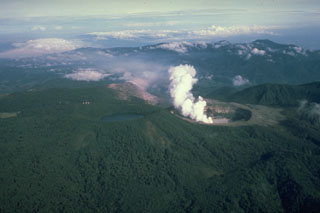Report on Poas (Costa Rica) — 4 June-10 June 2025
Smithsonian Institution / US Geological Survey
Weekly Volcanic Activity Report, 4 June-10 June 2025
Managing Editor: Sally Sennert.
Please cite this report as:
Global Volcanism Program, 2025. Report on Poas (Costa Rica) (Sennert, S, ed.). Weekly Volcanic Activity Report, 4 June-10 June 2025. Smithsonian Institution and US Geological Survey.
Poas
Costa Rica
10.2°N, 84.233°W; summit elev. 2697 m
All times are local (unless otherwise noted)
The Observatorio Vulcanológico y Sismológico de Costa Rica-Universidad Nacional (OVSICORI-UNA) reported continuing gas-and-steam emissions with occasional ash at Poás during 3-10 June. Significant amounts of gas-and-steam emissions were continuously and vigorously emitted at both Boca A and Boca C vents during the week, though there was a decreasing trend in the contribution of magmatic gases. Sulfur dioxide emissions decreased, though remained at high levels; the emissions were bluish in webcam images on 3 June and averaged 395 tonnes per day in satellite data on 4 June. Incandescence continued to be visible and detected in infrared webcam views at Boca A vent. The steam-and-gas plumes on 2 June contained minor amounts of ash. The steam-and-gas emissions at Boca A began to contain a moderate amount of ash at 0340 on 10 June and the ash content persisted for a few hours. The plumes rose as high as 1 km above the vent and drifted W. The volcano’s Alert Level remained at 3 (the second highest level on a four-level scale) and the Aviation Color Code remained at Orange (the second highest color on a four-color scale).
Geological Summary. The broad vegetated edifice of Poás, one of the most active volcanoes of Costa Rica, contains three craters along a N-S line. The frequently visited multi-hued summit crater lakes of the basaltic-to-dacitic volcano are easily accessible by vehicle from the nearby capital city of San José. A N-S-trending fissure cutting the complex stratovolcano extends to the lower N flank, where it has produced the Congo stratovolcano and several lake-filled maars. The southernmost of the two summit crater lakes, Botos, last erupted about 7,500 years ago. The more prominent geothermally heated northern lake, Laguna Caliente, is one of the world's most acidic natural lakes, with a pH of near zero. It has been the site of frequent phreatic and phreatomagmatic eruptions since an eruption was reported in 1828. Eruptions often include geyser-like ejections of crater-lake water.
Source: Observatorio Vulcanologico y Sismologico de Costa Rica-Universidad Nacional (OVSICORI-UNA)

